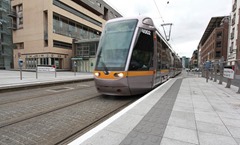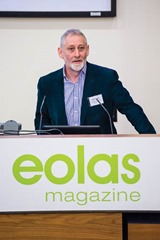Driving quality in public transport
 Coherence and confidence are the two main factors for a good public transport system, according to Gerry Murphy, Chief Executive of the National Transport Authority. He outlined the progress made since the authority’s formation at Transport Ireland.
Coherence and confidence are the two main factors for a good public transport system, according to Gerry Murphy, Chief Executive of the National Transport Authority. He outlined the progress made since the authority’s formation at Transport Ireland.
New technology is making the Irish public transport system more coherent and giving customers more confidence, National Transport Authority Chief Executive Gerry Murphy has stated. The authority has been operated since December 2009.
“We have achieved a lot in Ireland,” he told the Transport Ireland conference. “We have achieved it with limited resources and the drive … is to keep improving our public transport services.”
Definitions of good public transport vary. World Bank Vice-President Rachel Kyte has said that it must be “easy and convenient to use, fast, safe, clean and affordable.” Irish transport planners traditionally assumed that quality was linked to expensive infrastructure.
A University of California study found that discomfort was the least important factor for not using public transport. However, the University of Gothenburg, in Sweden, found that comfort was “very important” to bus passengers. Those surveyed had a “wide palette” for describing comfort, including the temperature on board, the availability of seats, the smell on board or whether or not the bus was driven smoothly.
In his own view, a good system is encompassed by two words: coherence and confidence. “If there’s a coherent public transport system, people perceive it as coherent: it’s legible [and] it’s understandable,” Murphy explained. “That engenders a confidence. That confidence leads to a forgiving if there are some failings. Because they are confident, people end up as ambassadors for the public transport system.”
The University of California study said that people were “quite forgiving” if traffic congestion caused delays in public transport because they understood that this was outside the control of the public transport company.
Leap cards
250,000 leap cards have now been issued since their launch in late 2011, raising €28 million and resulting in 18 million journeys. “Within the next three or four months, you will see a galloping change in its extent,” he said of the scheme.
Murphy was speaking just before the introduction of a fare cap on Irish Rail and the leap card’s launch on Wexford buses. An auto-load system will follow over the summer, allowing direct payments from a bank account. By late summer, all the Dublin Bus, Luas and Irish Rail products would have migrated to the leap card. The NTA’s target was to have 350,000 leap cards in operation by the end of the year. The cards would then be extended to commuter services in Cork and Galway.
He would have preferred that some of the infrastructure would have come “on stream” sooner but they were major projects and, as explained, would be well under way by the mid-year.
Enhancing the www.transportforireland.ie journey planner was also a priority for the NTA and Murphy was “very proud” of Ireland’s work. Only five other European countries have national transport planners: Finland, Sweden, Norway, the Netherlands and Denmark.
An app to accompany the website has been downloaded 86,000 times: 58,000 to iPhones. “Generally, we found across the apps a very strong use of iPhone in Ireland compared to android compared to other countries,” he remarked. Each month, around 500,000 trips were planned and over 1 million departure details, timetables and maps requested.
As for the next steps, Murphy wanted to see a route mapper for all services, showing alternatives to viewers as they hover over the map and using real-time information. A greater Dublin area cycle planner would show how public transport connects with cycle routes and lanes.
The NTA is close to its target of providing real-time information at 500 stops in greater Dublin and 100 stops in other cities. Dublin Bus now receives 4-5 million requests a week for real-time information: 80 per cent via apps and 20 per cent via the internet.
Regular surveys show that 93 per cent of times are accurate within three minutes and 90 per cent within one minute. Signs have been installed in Cork, Galway, Limerick and Waterford but have not yet been activated; the product depends on public confidence and the authority “wants to get the accuracy right.”
A metropolitan map for Dublin has been developed along with 14 local area maps. “They’re up on our website but that’s not where we really want them to be,” he added. “They need to be really out at places.” The electronic version of the map is already displayed alongside real-time information on information points at Heuston Station and Connolly Station and backlit paper displays are planned for other public places.
A “very comprehensive” review of the taxi system resulted in several changes which took effect in January. These include bans on renting taxi name plates, tinted windows, pick-ups and crew-cabs.
The review also introduced a requirement for the licence holder to own their vehicle and for the driver to notify the NTA when the vehicle is being operated (and whether it has been rented). Inactive licences can only be re-activated within one year, as opposed to the previous five-year timeframe.
Two apps for taxi driver tracking are also available: one for the industry and another for the public. The ‘Taxi Industry Portal’ app allows drivers to enter information as they have to be associated with a driver at any point in time. Drivers who do not have a smartphone can call a 24/7 call centre.
Using the ‘Driver Check’ app, consumers can enter the car registration number and the licence number for the driver or vehicle. This brings up the picture of the registered driver. Errors can be reported to the NTA (which can impose fines) and passengers can also forward the details to friends to assure them that they are heading home safely.
The NTA’s managing travel demand work encourages people to use other, more sustainable forms of transport. The Green Schools and Smarter Travel Workplaces programmes have been renewed for another three years. Initial results indicate that the workplace programme has achieved an 18 per cent reduction in car use.
These are now accompanied by the Smarter Travel Campus programme, launched in April. Students are “at a key point” as their modal choices would last long into their adult lives. This programme will be supported by a new website, optimised for mobile and tablet devices.
“Money isn’t a reason for not having a good public transport system,” he concluded, “because there is sufficient money there to run the services and to aim for a higher quality.”






